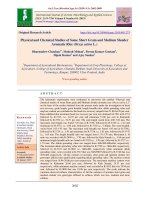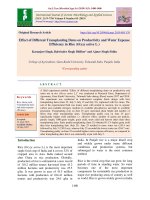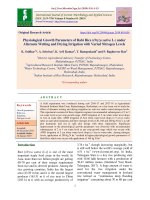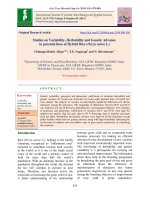Enhancing the performance of basmati rice (Oryza sativa L.) through fly ash and nitrogen management
Bạn đang xem bản rút gọn của tài liệu. Xem và tải ngay bản đầy đủ của tài liệu tại đây (132.87 KB, 7 trang )
Int.J.Curr.Microbiol.App.Sci (2019) 8(10): 2066-2072
International Journal of Current Microbiology and Applied Sciences
ISSN: 2319-7706 Volume 8 Number 10 (2019)
Journal homepage:
Original Research Article
/>
Enhancing the Performance of Basmati Rice (Oryza sativa L.)
through Fly Ash and Nitrogen Management
Gurpreet Singh and Balwinder Singh Dhillon*
College of Agriculture, Guru Kashi University, Talwandi Sabo, Punjab, India
*Corresponding author
ABSTRACT
Keywords
Basmati rice, Fly
ash, Grain yield,
Growth and
nitrogen
Article Info
Accepted:
15 September 2019
Available Online:
10 October 2019
A field experiment entitled “Enhancing the performance of basmati rice (Oryza sativa L.)
through fly ash and nitrogen management” was conducted during the kharif season of 2018
at Research Farm, Guru Kashi University, Talwandi Sabo, Bathinda (Punjab). The
experiment was laid out in split plot design with combination of three levels of fly ash
(control, fly ash @ 10 t ha-1, fly ash @ 20 t ha-1) in main plots and four levels of nitrogen
(40 kg N ha-1, 50 kg N ha-1, 60 kg N ha-1 and 70 kg N ha-1) in sub plots, replicated thrice.
Among the fly ash levels, application of fly ash 20 t ha -1 resulted in significantly higher
growth, yield attributes and grain yield of basmati rice than control and fly ash @ 10 t ha-1.
The application of 70 kg N ha -1 resulted in significantly higher growth, yield attributes and
grain yield of basmati rice than other nitrogen levels. Fly ash @ 20 t ha -1 with 70 kg N ha-1
recorded maximum growth and productivity of basmati rice, which was significantly
higher over all other treatments, but it was statistically at par with fly ash @ 20 t ha -1 and
60 kg N ha-1.
Introduction
Basmati rice known as “Queen of Rice” (bas
means aroma, mati means queen), occupies a
special status in developing countries. It has
great export potential due to its aroma, sweet
taste, dry and soft texture and excellent
cooking qualities (Sidhu et al., 2004). Rice is
highly
nutritive
crop
and
contains
carbohydrate,
protein,
fat,
minerals
(phosphorus, calcium, iron etc.) and amino
acids.
Fly ash is produced as a result of coal
combustion in thermal power station and
discharged in ash ponds. In India and most
countries major source of electrical energy is
coal based thermal power plants, which
produces 175 million tonnes. Disposal of high
amount of fly ash from thermal power plants
absorbs huge amount of water, energy and
land area by ash ponds. The fly ash utilization
in the country is estimated to be about 59%
only (Kanungo, 2013) Therefore fly ash
management would remain a great concern of
the century. However, several studies
purposed that fly ash can be used as a soil
ameliorant that may improve physical,
chemical, biological properties of the soil and
is a source of readily available plant micro and
2066
Int.J.Curr.Microbiol.App.Sci (2019) 8(10): 2066-2072
macro-nutrients. Addition of small amounts of
fly ash to soil neutralizes the acidity to a level
suitable for agriculture. Application of fly ash
increased the yield in various crops with
improvement in the physical, chemical and
biological properties and found beneficial for
soil and crop (Kohli et al., 2010). Nitrogen is
an essential constituent of proteins,
chlorophyll and metabolites such as alkaloids,
nucleotides, phosphatides, enzymes, vitamins
and hormones etc. which have great
importance in plant metabolism.
Nitrogen increase crop yield and protein
content in grains. It also promotes the
vegetative growth in rice. Nitrogen play a key
role in plant physiological processes
influenced the sink size thereby increasing the
grain yield of rice (Somasundaram et al.,
2002). Application of nitrogen fertilizer to the
basmati rice, leads to increase the plant height,
leaf size, number of panicle, number of
spikelet and grain yield (Balasubramanian
2002; Walker et al., 2008). Nitrogen is an
important component of rice production
technology with high yielding cultivars and its
important role in increasing rice productivity
(Kumar and Prasad, 2004). Keeping in view
the present study was planned to study the
effect of different levels of fly ash and
nitrogen on the performance of basmati rice.
Materials and Methods
The present investigation Enhancing the
performance of basmati rice (Oryza sativa L.)
through fly ash and nitrogen management was
conducted at Research Farm, University
College of Agriculture, Guru Kashi
University, Talwandi Sabo, Bathinda during
kharif season of 2018. Talwandi Sabo is
located at 29o 57 N latitude and 75o7 E
longitudes and altitudes (213 m above sea
levels). The tract is characterized by semi-arid
climate. Maximum temperature is about 45470C is not uncommon during summer, while
freezing temperature accompanied by frost
occurrence may be witnessed in the month of
December and January. The mean annual
rainfall fluctuates around 150 mm, major part
of which is during the month of July to
November. The soil of experimental field was
slightly alkaline (pH 7.8) with normal
electrical conductivity (1.41 dSm-1), low in
organic carbon content (0.29%) and available
nitrogen (233.7 kg ha-1), medium in available
phosphorus (15.0 kg ha-1) and available
potassium (216.8 kg ha-1). The experiment
was laid out in split plot design with three
replications. The treatment comprising of
three levels of viz., control, fly ash @ 10 t ha-1,
fly ash @ 20 t ha-1 and four levels of nitrogen
viz., 40 kg N ha-1, 50 kg N ha-1, 60 kg N ha-1
and 70 kg N ha-1.
The plant height, number of tillers and number
of effective tillers was counted manually from
randomly selected five plants at maturity in
each plot. The panicle length from base of
plant to tip of panicle from the five randomly
selected plants in each plot was measured and
average value was expressed in centimeters.
The dry matter accumulation was recorded
from each selected plants from each plot
firstly sun dried and then kept it in oven for 24
hrs at 650C then weighing and expressed it in
q ha-1. The weight of total produce per plot
was recorded after harvest of the crop with the
help of spring balance. The bundle weight was
taken before threshing and plot wise straw
yield was obtained after deducting the grain
weight from the whole bundle weight. The
weight of randomly 1000-grains was recorded
from each plot and expressed in g. The harvest
index was calculated by using following
formula:
Grain yield
Harvest Index (%) =
× 100
Biological yield
Fisher’s
2067
ANOVA
technique
and
least
Int.J.Curr.Microbiol.App.Sci (2019) 8(10): 2066-2072
significant difference (LSD) test at 5%
probability level was used to compare
differences among treatment means (Steel and
Torrie,1981).
Results and Discussion
Growth parameters of basmati rice
Amongst the fly ash levels, highest plant
height (117.4 cm) was recorded with the
application of fly ash @ 20t ha-1 which was
significantly higher than other treatments
(Table 1). Amongst the nitrogen levels,
highest plant height (116.8 cm) was recorded
with the application of nitrogen 70 kg N ha-1
which was significantly higher than other
treatments. The lowest plant height was
recorded with the application of 40 kg N ha-1.
Similar results were also reported by Reddy et
al., (2010) and Singh et al., (2007)
Significantly higher number of total tillers m-1
row length (82.5) was recorded with the
application of fly ash @ 20t ha-1 which was
significantly higher than other treatments,
whereas the lowest number of total tillers m-1
of row length (68.5) were recorded in control
(Table 1). Amongst the nitrogen levels, the
maximum number of tillers m-1 of row length
(79.6) was recorded with the application of 70
kg N ha-1. Similar results were also reported
by Mittra et al., (2005) and Sikdar et al.,
(2006).
Significantly higher dry matter accumulation
(143.3 q ha-1) was recorded with the
application of fly ash @20t ha-1 which was
significantly higher than other treatments
(Table 1). The lowest dry matter accumulation
(104.8 q ha-1) was recorded in 20 t fly ash ha-1
and 70 kg N ha-1. The nitrogen application @
70 kg ha-1 resulted in higher number of tillers
m-1 of row length (137.6). Similar results were
also reported by Deshmukh et al., (2000) and
Mannan et al., (2010).
Yield attributes of basmati rice
The application of fly ash@20 t ha-1 with 70
kg N ha-1 recorded maximum number of
effective tillers/m of row length (78.5) of
basmati rice, which was significantly higher
over all the treatments (Table 2). The lowest
number of effective tiller/m of row length was
recorded in treatment receiving no fly ash.
Amongst the nitrogen levels the maximum
number of effective tillers/m of row length
(74.6) was recorded with the application of 70
kg N/ ha-1. Similar results were also reported
by Das et al., (2013) and Sikdar et al., (2006).
Maximum panicle length (27.1) of basmati
rice was recorded in fly ash @ 20t ha-1 which
was significantly higher than control and fly
ash @ 10 t ha-1 (Table 2). Whereas, the
minimum panicle length (24.8 cm) was
recorded in control. The different levels of
nitrogen influenced the panicle length of rice,
Out of different levels of N, maximum panicle
length (26.3 cm) observed in 70 kg N ha-1,
which was significantly higher than other N
levels. The minimum panicle length (24.7 cm)
was recorded in 40 kg N ha-1. Similar result
were also reported by Karmakar et al., (2010)
and Bhattacharya and Singh (1991).
Amongst the different levels of fly ash, the
highest number of grains panicle-1 (104.3) of
basmati rice was recorded in fly ash @ 20 t ha1
, which was significantly higher than control
and fly ash @ 10t ha-1. The lowest number of
grains panicle-1 (86.3) was recorded in control.
The nitrogen levels also significantly increase
the number of grains panicle-1 of basmati rice.
It was observed that the highest mean number
of grains/panicle (100.4) was recorded in 60
kg N ha-1, which was significantly higher than
other N levels. The lowest number of grains
panicle-1 (88.1) was recorded in 40 kg N ha-1.
Similar results were also reported by Das et
al., (2013) and Mannan et al., (2010).
2068
Int.J.Curr.Microbiol.App.Sci (2019) 8(10): 2066-2072
Table.1 Growth parameters of basmati rice as influenced by different fly ash and nitrogen levels
Treatment
Fly ash levels (t ha-1)
Control
10
20
LSD (P=0.05)
Nitrogen levels (kg ha-1)
40
50
60
70
LSD (P=0.05)
Plant height
(cm)
Number of tillers m-1
row length
Dry matter
accumulation (q ha-1)
112.5
115.5
117.4
0.1
68.5
72.2
82.8
0.9
104.8
123.4
143.3
1.06
113.3
114.7
115.6
116.8
0.1
68.1
73.5
76.8
79.6
0.8
109.1
119.7
128.8
137.6
0.9
Table.2 Yield attributing characters of basmati rice as influenced by different fly ash and
nitrogen levels
Fly ash
No. of effective tillers
m-1 of row length
Fly ash levels (t ha-1)
Control
10
20
LSD (P=0.05)
Nitrogen levels (kg ha-1)
40
50
60
70
LSD (P=0.05)
Panicle length
(cm)
Number of grains
panicle-1
Test weight
(g)
63.1
67.3
78.5
0.9
24.8
25.1
27.1
0.2
86.3
92.8
104.3
0.8
20.8
21.1
20.9
NS
63
68.3
72.7
74.6
0.1
24.7
25.4
26.1
26.3
0.1
88.1
91.7
100.4
97.8
0.9
20.6
20.7
21.3
20.9
0.3
Table.3 Grain yield of rice as influenced by different levels of fly ash and nitrogen
Fly ash
levels
(t ha-1)
Control
10
20
Mean
LSD (P=0.05)
Grain yield (q/ha)
Nitrogen levels (kg ha-1)
40
50
60
39.4
41.7
42.7
40.5
42.9
45.2
43.7
46.9
48.5
41.2
43.8
45.4
Fly ash
Nitrogen
0.3
0.5
2069
Mean
70
43.5
46.8
49.3
46.5
41.8
43.8
47.1
44.2
Interaction
0.9
Int.J.Curr.Microbiol.App.Sci (2019) 8(10): 2066-2072
Table.4 Productivity of basmati rice as influenced by different fly ash and nitrogen levels
Treatment
Fly ash levels (t ha-1)
Control
10
20
LSD (P=0.05)
Nitrogen levels (kg ha-1)
40
50
60
70
LSD (P=0.05)
Straw yield
(q ha-1)
Biological yield
(q ha-1)
Harvest index
(%)
70.0
74.4
89.4
1.1
111.8
118.3
136.2
1.4
37.3
37.0
34.3
0.7
73.6
76.5
79.3
82.4
1.1
114.8
120.3
124.8
128.9
1.0
35.9
36.4
36.5
36.1
0.6
Test weight of basmati rice does not differed
significantly amongst fly ash levels (Table 2).
The effect of the increasing fly ash levels on
test weight was found be not significant.
Amongst the different nitrogen levels, more
1000-grain weight (21.3 g) obtained in 60 kg
N ha-1, which was significantly higher over
the other levels of nitrogen. The lowest 1000grain weight (20.6 g) was obtained in 40 kg N
ha-1. Similar results were also reported by
Singh et al., (2011).
Productivity of basmati rice
The interaction effects on grain yield of rice
were found to be significant (Table 3). Fly ash
@ 20 ha-1 recorded highest grain yield (49.3q
ha-1) under 70 kg N ha-1, which was
statistically at par with fly ash @ 20 t ha-1 and
60 kg N ha-1 and minimum grain yield (39.4 q
ha-1) was recorded in control (no fly ash) and
40 kg N ha-1.
The highest straw yield (89.1q ha-1) of
basmati rice was observed with the
application of fly ash @ 20 t ha-1, which was
significantly higher than control and fly ash
@ 10 t ha-1 (Table 4). The lowest straw yield
(70.0 q ha-1) of basmati rice was recorded in
control. The different levels of N also
increased the straw yield of basmati rice. The
highest straw yield (82.4 q ha-1) was observed
in 70 kg N ha-1, which was significantly
higher than other levels of N. The lowest
straw yield (73.6 q ha-1) was recorded in 40
kg N ha-1.This finding was in conformity with
that of Reddy et al., (2010) and Islam et al.,
(2008).
The highest biological yield (136.2 q ha-1)
was recorded in fly ash @ 20t ha-1) which was
significantly higher than control and fly ash
@10 t ha-1 (Table 4). The lowest biological
yield (105.6 q ha-1) was recorded in control.
The different N levels also increased the
biological yield of rice. Amongst the different
N levels the highest biological yield (128.9 q
ha-1) was recorded in 70 kg N ha-1) which was
significantly differed than other levels of N.
The lowest yield (114.8 q ha-1) was recorded
in 40 kg N ha-1.
Amongst the fly ash levels, the maximum
harvest index (37.3%) was observed in
control which significantly higher than fly ash
@10 t ha-1 and fly ash @ 20 t ha-1. The lowest
harvest index (34.3%) was recorded in fly ash
@ 20 t ha-1. The N levels also influenced the
harvest index percentage. The highest harvest
index (36.1%) was recorded in 60 kg N ha-1
2070
Int.J.Curr.Microbiol.App.Sci (2019) 8(10): 2066-2072
which significantly higher over other N
levels. The lowest harvest index (35.9%) was
recorded in 40 kg N ha-1.
In conclusion, application of fly ash @ 20 t
ha-1 resulted in maximum growth parameter,
yield attributes and grain yield, which was
significantly higher than control and fly ash
@10t/ha. Among the different nitrogen levels,
application of 70kg N ha-1 recorded the
maximum growth parameters, yield attributes
and grain yield of basmati rice than the lower
levels of N. The maximum grain yield
recorded with the application fly ash @ 20 t
ha-1 and 70 kg N ha-1 which significantly
higher but at par with fly ash @ 20 t ha-1 and
60 kg N ha-1. The data recommended that the
integration of fly ash @ 20 t ha-1 and 60 kg N
ha-1 is sufficient to get optimum yield of
basmati rice.
References
Anonymous (2018).Kharif crop outlook
2017/2018. Pp-24. International Rice
Research
Institute
(2002).
Rice
rd
Almanac, 3
Edition. (Gramene
Reference ID 8379)
Balasubramanian R (2002) Response of
hybrid rice (Oryza sativa L.) to levels
and time of application of nitrogen.
Indian Journal of Agronomy 47: 20306.
Bhattacharya H C and Singh K N (1991)
Response of direct-seeded rice to level
and time of nitrogen application. Indian
Journal of Agronomy 37: 681-85.
Das B K, Choudhary B H, Das K N (2013)
Effect of integration of fly ash with
fertilizers and Farm yard manure on
nutrient availability, Yield and nutrients
uptake of rice in Inceptisols of Assam,
India.
International
Journal
of
Advancements in Research and
Technology 2: 190-208.
Deshmukh A, Matti D B and Bharti B (2000)
Soil properties as influenced by
application of fly ash, Journal of Soils
and Crops 10:69-71.
Islam M S, Hossain M A, Chowdhury M A H
and Hannan M A (2008) Effect of
nitrogen and transplanting date on yield
and yield component of aromatic rice.
Journal of Bangladesh Agricultural
University 6:291-96.
Kanungo, S P (2013) Laboratory studies and
field application of fly ash in forest
nurseries and plantation at CSIRIMMT, National workshop on use of fly
ash in forestry and development of
degraded/wasteland,
helt
during
September 12-13, 2013,pp 23-33.
Karmakar, S, Mittra, B N and Ghosh, B C
(2010) Enriched coal ash utilization for
augmenting production of rice under
acid lateritic soil. Coal combustion and
Gasification products 2: 45-50.
Kohali, S J and Goyal, D (2010) Effect of fly
ash application on soil physical
properties and microbial activities of
soil. Acta Agrophysical 16(22), 327-35.
Mahaskar H V, Thorat S T, Dhagat S B
(2005) Effect of nitrogen on leaf area,
leaf area index and grain yield of
scented rice varieties. Journal of soil
and crop 5:218-20.
Mannan M A, Bhuiya M S U, Hossain H M A
and Akhand M I M (2010) Optimization
of nitrogen rate for aromatic basmati
rice (Oriza sativa L.). Bangladesh
Journal of Agriculture Research
35:157-65.
Matte, D B and Kene, D R (1995) Effect of
fly ash application on yield performance
of kharif and rabi crops. Journal of soils
and crops 5:133-36.
Mittra, B N, Karmakar, S, Swain, D K,
Ghosh, B C, (2005) Fly ash a potential
source of soil amendment and a
component of integrated plant nutrient
supply system. Fuel 84, 1447-51.
Reddy T, Prabhakar U, Rao M,
2071
Int.J.Curr.Microbiol.App.Sci (2019) 8(10): 2066-2072
Chandrasekhar R. (2010) Effect of fly
ash and Farm yard manure on soil
properties and yield of rice grown on an
inceptisols. Agricultural Science Digest
30:281-305.
Sidhu, M S, Sikka R and Singh T (2004)
Perforamnce of transplanted basmati
rice in different cropping systems as
effected by N application. International
Rice Research Notes 29:63-65.
Sikdar M S I, Rahman M M, Islam M S,
Yeasmin M S and akhtar M M (2006)
Effect of nitrogen levels on aromatic
rice varieties and soil fertility status.
International Journal of Sustainable
Crop Productivity 3:49-54.
Singh H and Thakur R B (2007) Effect of
level and scheduling of nitrogen
application on yield and quality of
Basmati rice. Journal of Applied
bioscience 33:118-21.
Singh J (2011) Enhancing the performance of
direct seeded Basmati rice (Oryza sativa
L.) through seed priming and N
management. M.Sc. Thesis, department
of Agronomy, PAU, Ludhiana.
Somasundaram
E,
Sathiyavelu
A,
Velayutham (2002) Effect of nitrogen
levels on growth and yield attributes of
rice under sodic soil condition. Madras
Agriculture Journal 89:506-08.
Steel, R G D and Torrie, J H. (1981)
Principles and procedures of statistics:
A biometrical approach. 2nd Edn.
McGraw-Hill, Singapore.
How to cite this article:
Gurpreet Singh and Balwinder Singh Dhillon. 2019. Enhancing the Performance of Basmati
Rice
(Oryza
sativa
L.)
through
Fly
Ash
and
Nitrogen
Management.
Int.J.Curr.Microbiol.App.Sci. 8(10): 2066-2072. doi: />
2072
![Chemical and functional components in different parts of rough rice (oryza sativa l[1] ) beforeandaftergermination](https://media.store123doc.com/images/document/14/rc/qa/medium_qab1394872940.jpg)








